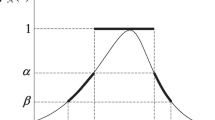Abstract
Formal concept analysis (FCA) and description logic (DL) are meant to be formalizations of concepts. A formal concept in the former consists of its intent and extent, where the intent is the set of all the attributes shared by each object in the extent of the concept, and the extent is the set of all the objects sharing each property in the intent of the concept. A concept in the latter formalization is simply a concept name, the interpretation of which is a subset of a universe. To consider the correspondence between concepts in both formalizations, a multi-valued formal context must be represented both as a knowledge base and as a model of the DL for contexts, where concepts are decomposed into tuple concepts C, interpreted as a set of tuples and value concepts V, interpreted as a set of attribute-value pairs. We show that there is a difference between the interpretation of concepts ∀R.V/∀R −.C and the Galois connection between the extent/intent of formal concepts in FCA. According to the Galois connection, there should be concepts of the form +∀R.V and +∀R −.C interpreted in FCA, and hence the logical language L for DL is extended to be L + together with +∀ as a constructor so that +∀R.V and +∀R −.C are well-defined concepts. Conversely, according to the interpretation in DL there should be pseudo concepts in FCA so that the interpretation of concepts ∀R.V/∀R −.C is the extent/intent of pseudo concepts. The correspondence between formal concepts and concepts in L +, and between pseudo concepts and concepts in L are presented in this paper.
Similar content being viewed by others
References
Calvanese D, De Giacomo G, Lenzerini M, et al. Source integration in data warehousing. In: Quirchmayr G, Schweighofer E, Bench-Capon T J M, eds. Proceedings of the 9th International Workshop on Database and Expert Systems Applications. New York: Springer, 1998. 192–197
Calvanese D, Lenzerini M, Nardi D. Description logics for conceptual data modeling. In: Chomicki J, Saake G, eds. Logics for Databases and Information Systems. Dordrecht: Kluwer Academic Publisher, 1998. 229–263
Beneventano D, Bergamaschi S, Lodi S. Terminological logics for schema design and query processing in OODBs. In: Baader F, Buchheit M, Jeusfeld M A, eds. Proceedings of 1st Workshop KRDB’94. 1994
Borgida A. Description logics for querying databases. In: Baader F, Lenzerini M, Nutt W, eds. Proceedings of the 1994 International Workshop on Description Logics. 1994
Borgida A, Lenzerini M, Rosati R. Description logics for data bases. In: Baader F, Calvanese D, McGuinness D L, et al., eds. The Description Logic Handbook. Cambridge: Cambridge University Press, 2002. 472–494
Lenzerini M. Description logics and their relationships with databases. In: Beeri C, Buneman P, eds. Database Theory — ICDT’99, LNCS, 1540. Berlin/Heidelberg: Springer, 1999. 32–38
Borgida A. Description logics in data management. IEEE Trans Knowl Data En, 1995, 7: 671–682
Canter B, Wille R. Formal Concept Analysis: Mathematical Foundations. New York: Springer-Verlag, 1999. 17–62
Saquer J, Deogun J S. Formal rough concept analysis. In: Zhong N, Skowron A, Ohsuga S, eds. New Directions in Rough Sets, Data Mining, and Granular-Soft Computing. Proceedings of 7th International Workshop, RSFDGrC’ 99. Berlin/Heidelberg: Springer, 1999. 91–99
Pagliani P. From concept lattices to approximation spaces: algebraic structures of some spaces of partial objects. Fund Inform, 1993, 18: 1–25
Wille R. Restructuring lattice theory: an approach based on hierarchies of concepts. In: Rival I, ed. Ordered Sets. Dordecht-Boston: Reidel, 1982. 445–470
Baader F, Calvanese D, McGuinness D L, et al. The Description Logic Handbook. Cambridge: Cambridge University Press, 2002. 45–138
Lutz C. Reasoning with concrete domains. In: Thomas D, ed. Proceedings of the 16th IJCAI. San Francisco: Morgan Kaufmann Publishers, 1999. 90–95
Wang J, Jiang Y C, Shen Y M. A satisfiability and reasoning mechanism of terminological cycles in description logic vL(in Chinese). Sci China Ser F-Inf Sci, 2009, 39: 205–211
Baader F, Ganter B, Sattler U, et al. Completing description logic knowledge bases using formal concept analysis. In: Manuela M V, ed. Proceedings of the 20th IJCAI. San Francisco: Morgan Kaufmann Publishers, 2007. 230–235
Baader F, Sertkaya B. Applying formal concept analysis to description logics. In: Eklund P, ed. Berlin/Heidelberg: Proceedings of ICFCA 2004. LNAI, 2961. Springer, 2004. 261–286
Burmeister P, Holzer R. Treating incomplete knowledge in formal concept analysis. In: Ganter B, Stumme G, Wille R, eds. Formal Concept Analysis. LNCS, 3626. Berlin/Heidelberg: Springer, 2005. 114–126
Huchard M, Napoli A, Rouane M H, et al. A proposal for combining formal concept analysis and description logics for mining relational data. In: Kuznetsov S O, Schmidt S, eds. Proceedings of ICFCA 2007. Berlin/Heidelberg: Springer, 2007. 51–65
Rudolph S. Exploring relational structures via FLE. In: Bubak M, Albada G D, Dongarra J J, et al., eds. Proceedings of ICCS04. Berlin: Springer-Verlag, 2004. 196–212
Author information
Authors and Affiliations
Corresponding author
Rights and permissions
About this article
Cite this article
Ma, Y., Sui, Y. & Cao, C. The correspondence between the concepts in description logics for contexts and formal concept analysis. Sci. China Inf. Sci. 55, 1106–1122 (2012). https://doi.org/10.1007/s11432-011-4376-7
Received:
Accepted:
Published:
Issue Date:
DOI: https://doi.org/10.1007/s11432-011-4376-7




